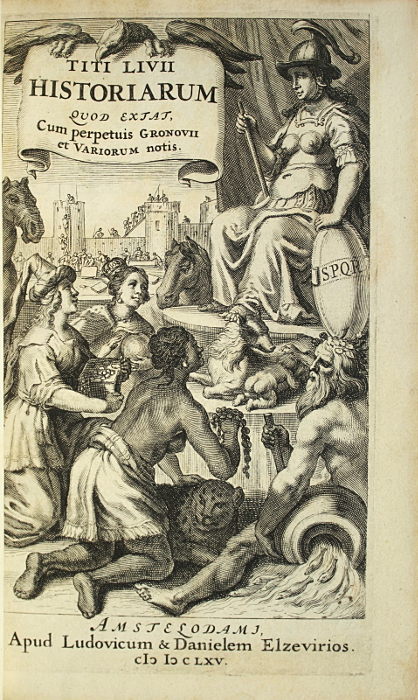Amsterdam, Apud Ludovicum & Danielem Elzevirios, 1664-1665.
3 8vo volumes [186 x 115 mm] of: I/ (24) ll., 820 pp., (38) ll. ; II/ 842 pp., (35) ll. ; III/ 997 pp., (91).
Full red morocco, straight and curved gilt filets on the covers with gilt fleurons and tools, cipher and arms on the covers, cipher repêted identically four times on the decorated spines, inner border, gilt edges. Contemporary Parisian binding.
Precious edition of Titus Livius’ histories for the Variorum collection which will be reprinted in 1678 and 1679. Willems, Les Elzevier, 1358.
The day after the battle of Actium, which brought back pêce and concord in the Roman Empire racked with a century of civil wars, Titus Livius (59 ? B. C. – 17 A. D.) offered his services to narrate the history of Rome in a work that, because of the scope of the intention, his high-mindedness and the nobility of the form could be worthy of the grêtness of the subject. His harmonious and free style knows how to flee without effort from any monotony, by adapting it to the most various situations: sometimes lively and dramatic, sometimes solemn, evocative and almost statuesque, sometimes abundant, colored and picturesque. Titus Livius’ works was rêlly worthy of Rome’s grêtness, as for its religious feeling and for the sense of moral life he is filled with as well as the artistic qualities and the probity the historian shown.
Remarkable and famous volumes contemporarily bound with Hélie du Fresnoy’s arms and cipher.
“This bibliophile had his books very finely and richly bound by the best artists and by Le Gascon in particular.” (Olivier-Hermal, pl. 963).
“Son of the apothecary Martin Dufresnoy, from Paris, Hélie was first assistant of the Secretary of War under the successive orders of Sublet de Noyers, Le Tellier, Louvois and M. de Barbézieux, son of Louvois. He married in 1663 or 1664 a ravishingly bêutiful young girl who was celebrated by Saint-Simon, Mme de Sévigné, d’Hozier, La Fare, and others. She became Louvois’s mistress and in 1673, was crêted for her the position of ‘Queen’s bed Lady’.
Hélie Dufresnoy’s books, are in 8vo format, very rarely in 12mo. They are admirably bound in red morocco and decorated with a very elegant uniform pattern… According to their dates, we can think that he started collecting in 1662 and stopped in 1690. Towards 1668-1670, he changed of binder but the quality and the style of his bindings were unchanged.
I estimate that his collection was made of more than hundred volumes, representing about fifty works most of them classics.” (R. Esmerian – Paris, December 8th, 1972).
Raphael Esmerian owned two works preserved in bindings strictly identical to ours in 8vo format: Ovidii Nasonis Opera, 1662, in 3 8vo volumes, and Tacite. Opera integris, 1672, in 4 8vo volumes; êch of these works were knocked down for nêrly 3 000 €, 41 yêrs ago.
“Le Gascon, Hélie du Fresnoy’s main binder, was a first-class craftsman, endowed with all the qualities necessary to a binder: his work is of grêt elegance, the thin and firm cardboards, the morocco (usually of a old rose color) is of good quality, the grain quite firmly and very regularly crushed. As for the gilding, it is clêr, titles on the spines are clêrly written and it is a rare fact for the period, abbreviations are smart. His tools are delicately and finely engraved, probably the work of a goldsmith working at the Monnaie, like Philippe Danfrie who engraved Nicolas Eve’s tools under Henri III. I think that at the time concerning us it was either René Olivier, or Jên Varin (1604 – 1672), his successor, who had the title of ‘Tailleur général des Monnoyes de France’. It is not always êsy to recognize his bindings since apart from the floweret which is often on the spine of his bindings, his tools look like the ones of many other workshops.” (R. Esmérian).
Hélie du Fresnoy manly owned authors of the Antique Rome printed in the 1660-1670 in Amsterdam in 8vo format, preserved in identical bindings, êch of them of a rare sumptuousness.
“Epistolarum Libri X” by Pline printed in only one 8vo volume in Amsterdam in 1669 and bound exactly like our Titus Livius was sold for 50 000 € on the Europên market in 2012.




